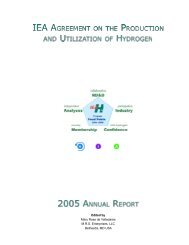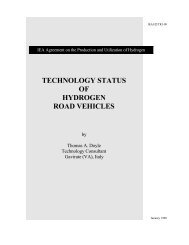Review of Small Stationary Reformers for Hydrogen Production
Review of Small Stationary Reformers for Hydrogen Production
Review of Small Stationary Reformers for Hydrogen Production
Create successful ePaper yourself
Turn your PDF publications into a flip-book with our unique Google optimized e-Paper software.
� Researchers at Ishikawajima-Harima Heavy Industries (Tokyo, Japan) have patented a<br />
plate-type steam methane re<strong>for</strong>mer (Hamada et al. 1997).<br />
� International Fuel Cells holds a patent on a plate-type re<strong>for</strong>mer (LeSieur 1998).<br />
� Researchers at Ztek Corporation (Hsu et al. 2001) have patented a plate-type re<strong>for</strong>mer<br />
that can be operated as a steam re<strong>for</strong>mer or a partial oxidation system.<br />
Plate-type steam methane re<strong>for</strong>mers have not yet been commercialized <strong>for</strong> fuel cell<br />
systems, but may allow <strong>for</strong> future capital cost reductions by simplifying system design.<br />
d. Membrane Reactors <strong>for</strong> Steam Re<strong>for</strong>ming<br />
Another promising technology is the “membrane reactor”, where the steam re<strong>for</strong>ming, water<br />
gas shift and hydrogen purification steps all take place in a single reactor. Methane and<br />
steam are fed into a catalyst-filled reactor under pressure. On one side <strong>of</strong> the reactor is a<br />
high selectivity palladium membrane that is selectively permeable to hydrogen. As the steam<br />
re<strong>for</strong>ming reaction proceeds, the hydrogen is driven across the membrane by the pressure<br />
difference. Depending on the temperature, pressure and the reactor length, methane can be<br />
completely converted, and very pure hydrogen is produced. Very pure hydrogen is removed<br />
as the reaction proceeds. This allows lower temperature operation, and lower cost<br />
materials. A potential advantage <strong>of</strong> this system is simplification <strong>of</strong> the process design and<br />
capital cost reduction, because fewer process vessels will be needed.<br />
There is a large amount <strong>of</strong> industrial R&D activity on membrane technologies <strong>for</strong> syngas and<br />
hydrogen production. Interest by major energy companies in applying membrane<br />
technology to large-scale syngas and hydrogen production may have significant ”spin-<strong>of</strong>fs”<br />
<strong>for</strong> small-scale hydrogen production as well. Recently patents have been issued on<br />
membrane reactor re<strong>for</strong>ming to a number <strong>of</strong> companies involved in fuel processor design <strong>for</strong><br />
fuel cells and on related ion transport membrane technology to oil companies, Exxon, BP<br />
Amoco, Standard Oil, and industrial gas companies, Air Products and Praxair (see Appendix<br />
B).<br />
� Recently Praxair and Argonne National Laboratory (Shah, M., R.F. Drnevich and U.<br />
Balachandran 2000) launched a program to develop a compact, low-cost hydrogen<br />
generator based on ceramic membrane technologies. Steam, natural gas and oxygen<br />
are combined in a catalyzed autothermal re<strong>for</strong>ming reaction. Oxygen is derived from air,<br />
using an oxygen transport ceramic membrane (OTM) that operates at about 800-<br />
1000 o C. High purity hydrogen is removed using a high selective hydrogen transport<br />
membrane, also operating at 800-1000 o C. The OTM has been developed by Praxair<br />
and others in the Oxygen Transport Membrane Syngas Alliance (BP Amoco, Statoil,<br />
Sasol), beginning in 1997, and is now undergoing Phase II pilot demonstration. The<br />
hydrogen transport membrane is being developed at Argonne National Laboratory, and<br />
is in an earlier stage <strong>of</strong> development.<br />
� Tokyo Gas company has built and tested a small membrane reactor <strong>for</strong> production <strong>of</strong><br />
pure hydrogen from natural gas (Seki et al. 2000) at a rate <strong>of</strong> 15 Nm 3 /h (about 12,000<br />
scf/d), as well as steam re<strong>for</strong>ming and partial oxidation systems.<br />
11













